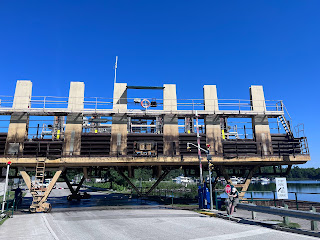While the Trent Severn took a little longer than anticipated, we left Orillia on Thursday 7/14 pretty much on schedule. Our plan was to get to the Big Chute and over it, if possible on Thursday. Our backup was to spend the night at the marina just before the Big Chute. With the Big Chute closed to big boats over the weekend, we wanted to make it over before Saturday. There were a few lakes along the way where Egret could stretch her legs, but there were also some swing bridges and a few locks which are unknown in terms of how long it’s going to take for passage.
The first swing railroad bridge for the Canadian Railway was the most problematic. We’ve heard horror stories of a cantankerous bridge tender who can make you wait for hours to get passage. I knew that if I had to I could take down our VHF antenna and slide through with inches to spare, but that wasn’t my first option. Fortunately, the bridge tender acknowledged us and began the process of opening fairly quickly. In the bridge tender’s defense, the process of opening the bridge is not easy and straightforward. He needs to climb down from his tower, walk across the bridge, start a small gas engine, return to his tower, and open the bridge. I’m sure he has to reverse the process when we clear through. At any rate, we made it through without incident and we were on our way. The remaining swing bridge and locks were transited without issue and we were actually making great time.
Have I mentioned how shallow the route is on the Trent Severn? Sadly, we discovered the functionality of our depth alarm AFTER the little issue in the Niantic River on our second day. We initially set the alarm at 10 feet, then we got into the Trent Severn and adjusted it to 6 feet because it was constantly going off – now we’re at 4 feet. We draw 3 feet 3 inches – so that’s a whopping 9 inches of warning that we’ve got. Our routine is that Chrisy is on the iPad looking at Aquamaps while I’m driving and looking at Navionics. The channel is well marked but heaven help you if you get outside of it. There are no soft groundings in Canada; it’s all rock. There’s a prop repair shop in almost every harbor for a reason.
We arrived at the Big Chute in great time, hitting the blue line, and staging area, at 4 PM. We were the second group to go over so we were able to see how it works before we went. It was also very therapeutic for Chrisy to be able to see what lay in store for her. As I mentioned in a previous post the Big Chute is a cross between a marine travel lift and a San Francisco cable car. We are over!









Fascinating, that you're a twin-screw. Didn't think you're big enough to need that. Do you need to tip or bribe Portage or Lock keepers?
ReplyDeleteAs well, surprised you don't have a jet drive for the picnic boat and load draft / river conditions
ReplyDelete